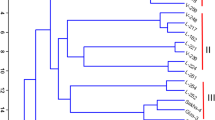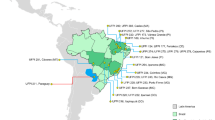Abstract
The antinutritional factors (ANFs) present in Vicia spp. seeds are a major constraint to the wider utilization of these crops as grain legumes. In the case of faba bean (Vicia faba L.), a breeding priority is the absence vicine and convicine (v-c); responsible for favism in humans and for the reduced animal performance or low egg production in laying hens. The discovery of a spontaneous mutant allele named vc-, which induces a 10–20 fold reduction of v-c contents, may facilitate the process. However, the high cost and difficulty of the chemical detection of v-c seriously restricts the advances in breeding-selection. To identify random amplified polymorphic DNA (RAPD) markers linked to this gene, we have analysed an F2 population derived from a cross between a line with high v-c content (Vf6) and the vc- genotype (line 1268). Quantification of v-c was done by spectrophotometry on the parents and the F2 population (n = 136). By using bulked segregant analysis (BSA), two RAPD markers linked in coupling and repulsion phase to the allele vc- were identified and further converted into sequence characterized amplified regions (SCARs). Amplification of SCARS was more consistent, although the initial polymorphism between pools was lost. To recover the polymorphisms several approaches were explored. Restriction digestion with HhaI (for SCAR SCH01620) and RsaI (for SCAR SCAB12850) revealed clear differences between the parental lines. The simultaneous use of the two cleavage amplified polymorphism (CAP) markers will allow the correct fingerprinting of faba bean plants and can be efficiently used in breeding selection to track the introgression of the vc- allele to develop cultivars with low v-c content and improved nutritional value.




Similar content being viewed by others
References
Albano E, Tomasi A, Mannuzzu L, Arese P (1984) Detection of a free radical intermediate from divicine of Vicia faba. Biochem Pharmacol 33:1701–1704
Alzate-Marin AL, Menarim H, Asis de Carvalho G, de Paula Junior TJ, Gonçalves de Barros E, Alves Moreira M (1999) Improved selection with newly identified RAPD markers linked to resistance gene to four pathotypes of Colletotrichum lindemuthianum in common bean. Genet Resist 89:281–285
Avila CM, Sillero JC, Rubiales D, Moreno MT, Torres AM (2003) Identification of RAPD markers linked to Uvf-1 gene conferring hypersensitive resistance against rust (Uromyces viciae-fabae) in Vicia faba L. Theor Appl Genet 107(2):353–358
Bennett MD, Leitch I (1995) Nuclear DNA amounts in angiosperms. Ann Bot 76:113–176
Campell LD, Olaboro G, Marquardt RR, Waddel D (1980) Use of fababeans in diets for laying hens. Can J Anim Sci 60:395–405
Cheng FS, Weeden NF, Brown SK (1996) Identification of codominant RAPD markers linked to fruit skin color in apple. Theor Appl Genet 93:222–227
Chowdhury MA, Andrahennnadi CP, Slinkard AE, Vandenberg A (2001) RAPD and SCAR markers for resistance to ascochyta blight in lentil. Euphytica 118:331–337
Deng Z, Huang S, Xiao S, Gmitter FG (1997) Development and characterization of SCAR markers linked to the citrus tristeza gene from Poncirus trifoliata. Genome 40:697–704
Duc G, Sixdenier G, Lila M, Furtoss V (1989) Search of genetic variability for vicine and convicine content in Vicia faba L. A first report a gene which codes for nearly zero-vicine and zero-convicine contents. In: Huisman J, Van der Poel AFB, Liener IE (eds) Recent advances of research in antinutritional factors in legume seeds. Wageningen Academic Publishers, Wageningen, pp 305–313
Duc G, Marget P, Esnault R, LeGuen J, Bastianelli D (1999) Genetic variability for feeding value of faba bean seeds (Vicia faba): comparative chemical composition of isogenics involving zero-tannin and zero-vicine genes. J Agr Sci 133: 185–196
Duc G, Marget P, Page D, Domoney C (2004) Facile breeding markers to lower contents of vicine and convicine in faba bean seeds and trypsin inhibitors in pea seeds. In: Muzquiz M, Hill GD, Cuadrado C Pedrosa MM, Burbano C (eds) Recent advances of research in antinutritional factors in legume seeds and oilseeds. Wageningen Academic Publishers, Wageningen, pp 281–285
FAOSTAT (2004) http://www.fao.org/. Statistical Database
Ford R, Pang ECK, Taylor P (1999) Genetics of resistance to Ascochyta blight of lentil and the identification of closely linked RAPD markers. Theor Appl Genet 98:93–98
Friedman M (1996) Nutritional value of proteins from different food sources. A review. J Agric Food Chem 44:6–29
Frohlich AA, Marquardt RR (1983) Turnover and hydrolysis of vicine and convicina in avian tissues and digesta. J Sci Food Agric 34:153–163
Gill GP, Harvey CF, Gardner RC, Fraser LG (1998) Development of sex-linked PCR markers for gender identification in Actinidia. Theor Appl Genet 97:439–445
He Q, Viljanen MK, Mertsola J (1994) Effects of thermocyclers and primers on the reproducibility of banding patterns in randomly amplified polymorphic DNA analysis. Mol Cell Probes 8:155–160
Hegazy M, Marquardt RR (1983) Development of a simple procedure for the complete extraction of vicine and convicine from faba beans (Vicia faba L.). J Sci Food Agric 34:100–108
Hernández P, Hemmat M, Weeden NF, Dorado G, Martín A (1999) Development and characterization of Hordeum chilense chromosome-specific STS markers suitable for wheat introgression and marker-assisted selection. Theor Appl Genet 98:721–727
Jones CJ, Edwards KJ, Castaglione S, Winfield MO, Sala F, Van de Wiel C, Bredemeijer G, Vosman B, Matthes M, Daly A, Brettschneider R, Bettini P, Buiatti M, Maestri E, Malcevschi A, Marmiroli N, Aert R, Volckaert G, Rueda J, Linacero R, Vazquez A, Karp K (1997) A: Reproducibility testing of RAPD, AFLP and SSR markers in plants by a network of European laboratories. Mol Breed 3:381–390
Kosambi DD (1944) The estimation of map distance from recombination values. Ann Eugen 12:172–175
Lander ES, Green P, Abrahamson J, Barlow A, Daly MJ, Lincoln SE, Newburg L (1987) MAPMAKER: an interactive computer program for constructing genetic linkage maps of experimental and natural populations. Genomics 1:174–181
Mager J, Glaser G, Razin A, Izak G, Bien S, Noam M (1965) Metabolic effects of pyrimidines derived from faba bean glycosides on human erythrocytes deficient in glucose-6-phosphate deshydrogenase. Biochem Bioph Res Co 29:235–240
Marquardt RR, Bell JM (1988) Future potential of pulses for use in animal feeds. In: Summerfield RJ (eds) World crops: cool season food legumes. Martinus Nijhoff/Dr. W. Junk Publishers, Dordrecht, pp 421–444
McClendon MT, Inglish DA, McPhee KE, Coyne CJ (2002) DNA markers linked to Fusarium wilt race 1 resistance in pea. J Am Soc Hortic Sci 127(4):602–607
Michelmore R, Paran I, Keselli V (1991) Identification of markers linked to disease-resistance genes by bulk segregant analysis: a rapid method to detect markers in specific genomic regions by using segregating populations. Proc Natl Acad Sci USA 88:9828–9832
Muduuli DS, Marquardt RR, Guenter W (1982) Effect of dietary vicine and vitamin E supplementation on the productive performance of growing and laying chickens. Brit J Nutr 47(1):53–60
Paran I, Michelmore R (1993) Development of reliable PCR-based markers linked to downy mildew resistance genes in lettuce. Theor Appl Genet 85:985–993
Quemener B (1988) Improvements in the high-pressure liquid chromatographic determination of amino sugars and alpha-galactosides in faba bean, lupine and pea. J Agric Food Chem 36:754–759
Silva GF, Santos JB, Patto Ramalho MA (2003) Identification of SSR and RAPD markers linked to a resistance allele for angular leaf spot in the common bean (Phaseolus vulgaris) line ESAL 550. Genet Mol Biol 26(4):459–463
Sirks MJ (1931) Beitrage zu einer genotypischen analyse der ackerbohne Vicia faba L. Genetika 13:210–631
Sixdenier G, Cassecuelle F, Guillaumin L, Duc G (1996) Rapid spectrophotometric method for reduction of vicine and convicine in faba bean seed. FABIS Newslett 38/39:42–44
Tanksley SD, Young ND, Paterson AH, Bonierbale MW (1989) RFLP mapping in plant breeding: new tools for an old science. Bio/Technology 7:257–264
Torres AM, Weeden NF, Martín A (1993) Linkage among isozyme, RFLP and RAPD markers in Vicia faba. Theor Appl Genet 85:937–945
Vilariño M, Métayer JP, Crépon K, Duc G (2006) Effect of vicine-convicine and tannin contents of faba bean (Vicia faba L.) on AMEn and apparent protein digestibility values in broiler chicken. Anim Feed Sci Technol (Submitted)
Weeden NF, Timmermann GM, Hemmat M, Kneen BE, Lodhi MA (1992) Inheritance and reliability of RAPD markers. In: application of RAPD technology to plant breeding. Proceedings of the joint plant preceeding symposium series, Crop Science Society America, Madison, pp 12–17
Williams JGK, Kubelik AR, Livak KJ, Rafalski JA, Tingey SV (1990) DNA polymorphisms amplified by arbitrary primers are useful as genetic markers. Nucleic Acids Res 18:6531–6535
Young R, Kelly JD (1997) RAPD markers linked to three major anthracnose resistance genes in common bean. Crop Sci 37:940–946
Zhang Y, Stommel JR (2001) Development of SCAR and CAPS markers linked to the Beta gene in tomato. Crop Sci 41:1602–1616
Acknowledgments
This study was funded by the grants PETRI 95–0682-OP from the Spanish Science and Technology Ministry and by the European Community project EUFABA QLK5-CT2002-02307. The authors thank B. Raffiot, J. Prieto and G. de Lara for their excellent technical assistance. N. Gutierrez acknowledges a fellowship from the Consejería de Innovación Ciencia y Empresa from the Junta de Andalucía. C.M. Avila acknowledges financial support from the Spanish Ministerio de Educación y Ciencia (“Juan de la Cierva program”).
Author information
Authors and Affiliations
Corresponding author
Additional information
Communicated by D.A. Hoisington.
Electronic supplementary material
Rights and permissions
About this article
Cite this article
Gutierrez, N., Avila, C.M., Duc, G. et al. CAPs markers to assist selection for low vicine and convicine contents in faba bean (Vicia faba L.). Theor Appl Genet 114, 59–66 (2006). https://doi.org/10.1007/s00122-006-0410-3
Received:
Accepted:
Published:
Issue Date:
DOI: https://doi.org/10.1007/s00122-006-0410-3




